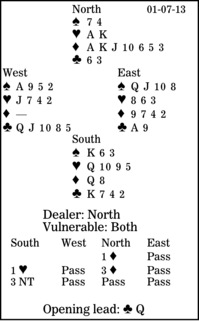Bridge column, January 7: Count the winners to beat the contract

As a bridge player, your target is always the number of tricks needed to make or to break a contract. When on defense, always ask yourself where your side might take those tricks -- what I call the defensive target.
In this deal, how should East defend against three no-trump after West leads the club queen?
West might have made a takeout double on the first round, which would have shown four spades and four or more clubs. His point-count was low, but if he could have found a fit with his partner, maybe his side could have done well. North was a trick too strong for his three-diamond rebid, but nothing else was better. And South went for the nine-trick game.
It is common in no-trump to return your partner's suit. (In a trump contract, this happens much less often.) Here, though, if East wins with his club ace and leads back the club nine, how many tricks will declarer take?
Even if South is void in diamonds, he must have at least 10 winners: two hearts, seven diamonds and one club -- not good.
The only chance for the defense is to cash four spade tricks immediately. East should take his club ace and shift to the spade queen. Here, East and West take the checkered flag.
** ** **
COPYRIGHT: 2013, UNITED FEATURE SYNDICATE
DISTRIBUTED BY UNIVERSAL UCLICK FOR UFS


Comments
Seymour Peckins
Mon, Jan 7, 2013 : 10:18 p.m.
Hy all, Last saturday's column was not correct. The diagram was right but the title and word's were wrong. I will attempt to attach it. I wish someone would correct the columnists name. It's Phillip Alder. Happy reading. Seymour Peckins Bridge column Saturday, January 05, 2013 By Phillip Alder If it looks weird, it is weird ( Diagram belongs here) Hunter S. Thompson, a journalist and author who died in 2005, said, "When the going gets weird, the weird turn pro." If it looks weird, talks weird and smells weird, it must be weird – especially if produced by a pro. In other words, if a competent player does something weird, it is (almost certainly) not because he has lost his marbles, but because he is hoping to sneak a trick past an unsuspecting opponent. n today's deal, South is in three no-trump. East is under the spotlight. West leads a fourth highest club six. What should East be thinking? First, though, let's look at declarer's problem. He has only eight top tricks: five spades, two diamonds and one club. And with clubs wide open, he must hope that East has the heart ace and is sleeping soundly. South should win the first trick and call for the heart jack, trying to look like a man about to take a finesse. What should East conclude now? Initially, East should have asked himself this question: What is declarer likely to do at trick two? Here, if South doesn't have the spade ace, he will surely establish that suit. So, when South doesn't do that, it is because he has the spade ace. Ergo, the suit is ready to run and declarer has eight top tricks: five spades, two diamonds and one club. Why is he calling for the heart jack? South must be trying to sneak his ninth trick. East mustn't fall for it: He should jump in with the heart ace and play clubs. If East ducks, South, in desperation, will put up his king and, when it wins, claim. he correct column now